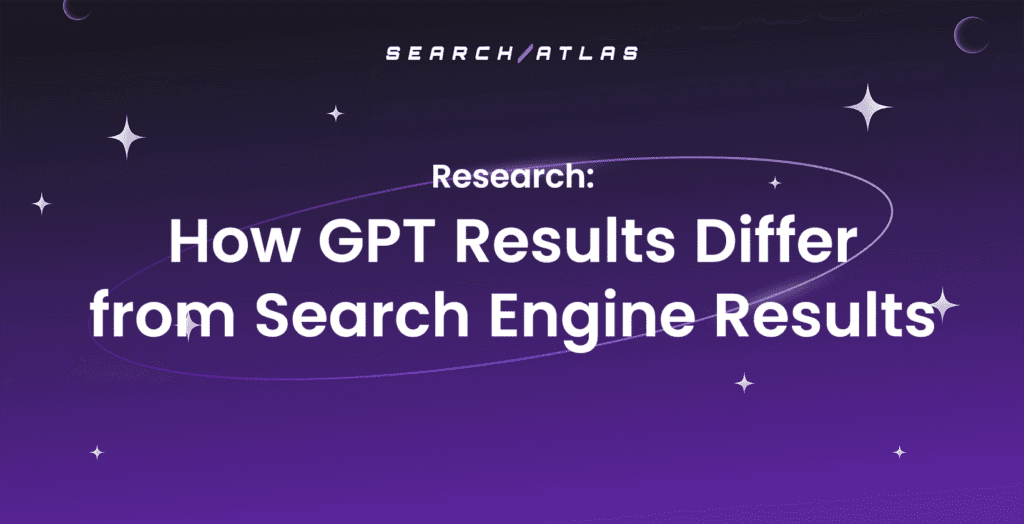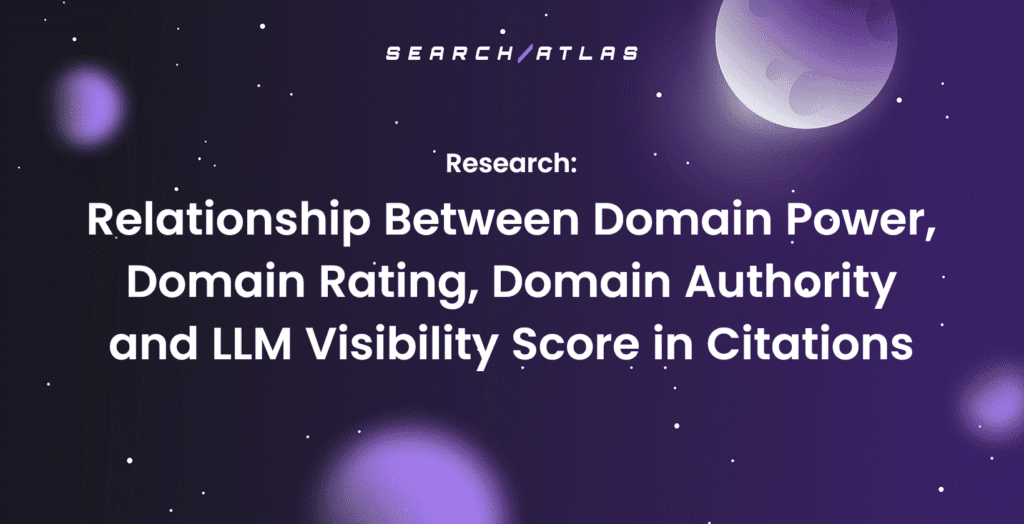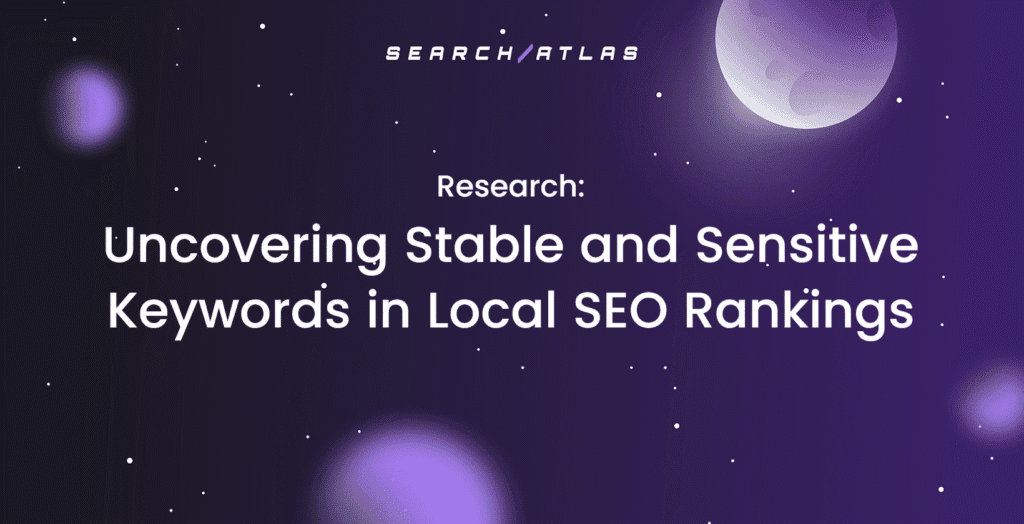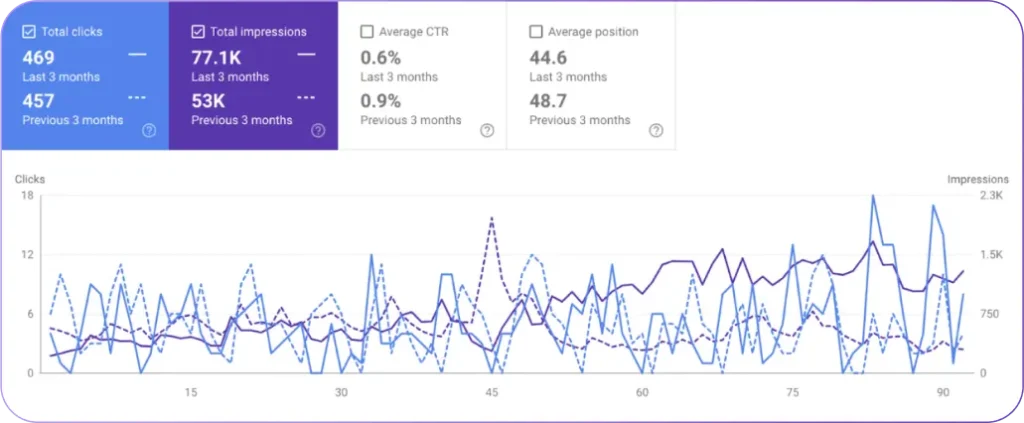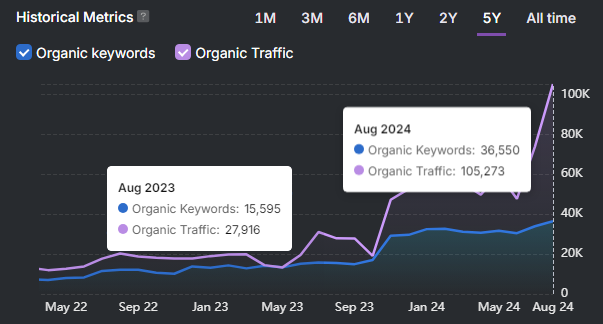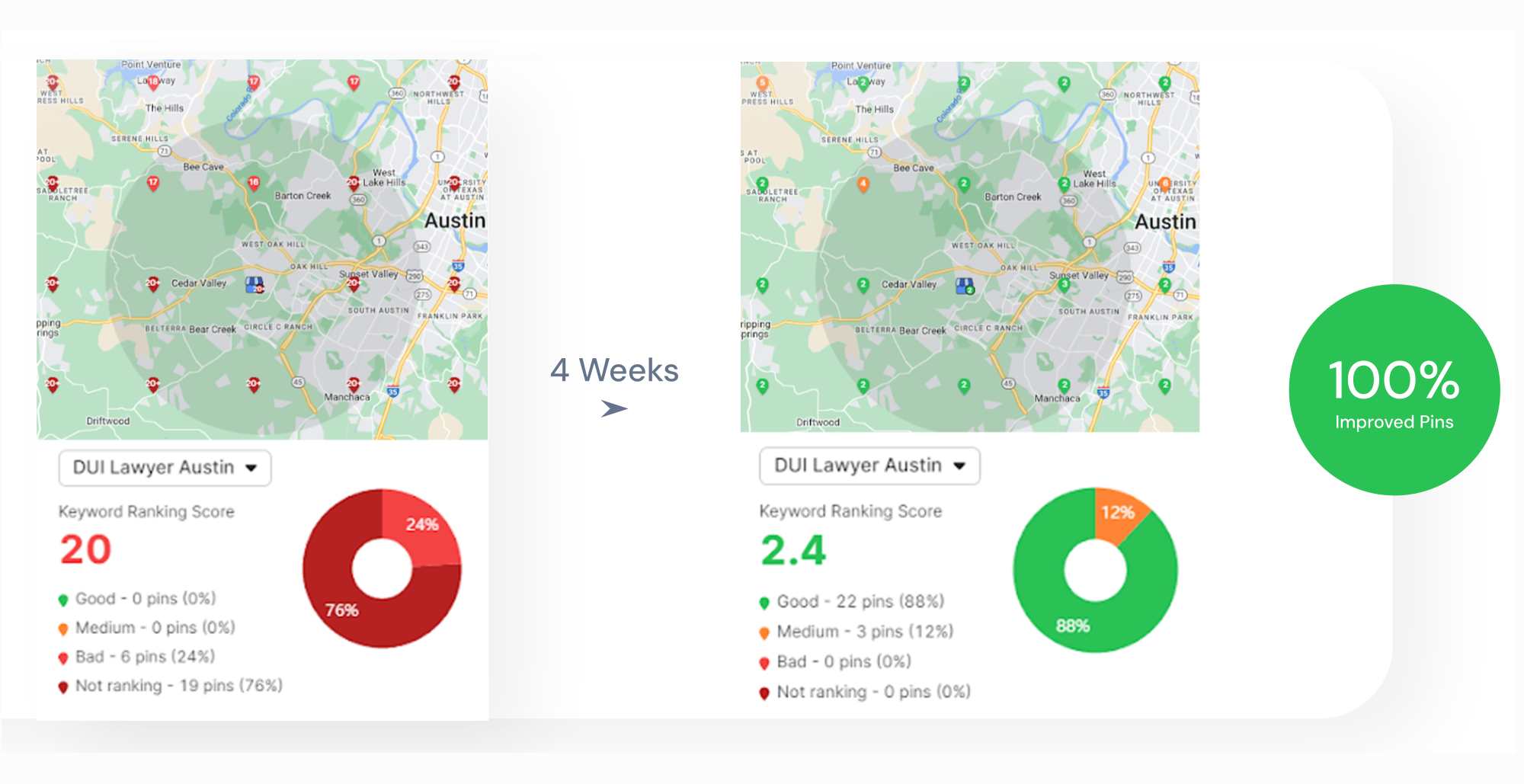You may also read a concise version of this research in our blog: Quantifying the SEO Impact of Backlink Placement Quality and Relevance on Search Engine Rankings.
1. Executive Summary:
High-quality backlinks are a long-recognized Google-ranking factor, and leveraging them to drive search engine visibility is a common SEO practice. However, there is less consensus on what backlink characteristics have the greatest impact on visibility, and despite widespread industry belief in the power of backlinks to strengthen domains, quantifying their true impact on a per-page basis remains challenging. Our work helps bridge that gap.
This white paper investigates how building backlinks to target landing pages impacts key SEO outcomes at the page level: organic clicks, search impressions, ranking positions, and total keyword rankings. It also identifies which linking domain characteristics drive the strongest outcomes. The study shows that strategic backlink placements can result in traffic gains exceeding 200% and average ranking improvements of 10.8% at the individual page level—not just at the domain level.
At the heart of our analysis is the distinction between multiple domain quality metrics: Domain Power (DP), Domain Rating (DR), and Domain Authority (DA).
- DA (Moz) and DR (Ahrefs) measure a domain’s overall backlink profile strength.
- Domain Power (DP), a proprietary Search Atlas metric, estimates real-world SEO impact using link velocity, referring domain diversity, and historical traffic uplift signals.
Using a rigorous data science methodology, we analyzed pre- and post-placement performance across thousands of real-world pages and backlink placements. Our findings confirm:
- Backlinks from stronger domains, especially those with high Domain Power, are consistently associated with more keyword rankings, greater organic visibility, and stronger average positions.
- In all cases, the “After Placement” group outperformed the “Before Placement” group, with ranking keyword and traffic gains often exceeding 200%.
- Anchor text relevance also improved post-placement, suggesting not only more backlinks but also better contextual alignment, contributing to stronger SEO impact.
In short, high-quality backlinks remain one of the most reliable drivers of SEO growth.
Marketers and SEOs should prioritize domain strength and contextual relevance in their link-building strategies to maximize ROI, especially when targeting specific landing pages.
2. Introduction
In today’s competitive digital landscape, securing organic rankings in search engines remains a critical driver of long-term visibility online. However, it is an industry reality that a vast majority of online content fails to attract any organic search traffic—making it imperative for businesses to find a competitive edge.
As businesses and publishers compete for attention in search results, backlinks—links from external websites to specific landing pages—continue to play a central role in modern SEO strategies.
Yet despite their strategic importance, the impact of backlinks is debated in the SEO industry as search engines regularly update their ranking algorithms. Are backlinks truly moving the needle for organic rankings, or are they an outdated tactic in a world increasingly shaped by semantic relevance, user signals, and machine learning?
This white paper investigates that essential question using a robust, data-driven approach.
Leveraging a large-scale dataset of 350,159 backlink placements across 13,002 unique target landing pages, we measure how backlinks influence four of the most meaningful SEO performance indicators at the individual page level:
- Organic clicks (clicks on a search result in Google)
- Search impressions (visibility in search results)
- Average ranking position (mean page-level position in SERPs)
- Number of ranking keywords (topical breadth for each landing page)
We go beyond simplistic correlation and apply rigorous methods—including non-parametric statistical tests, regression modeling, and machine learning (XGBoost)—to evaluate the before-and-after impact of link placement, all while accounting for variation in linking domain quality metrics, such as Domain Authority (DA), Domain Rating (DR), and a proprietary Domain Power (DP) metric.
The results not only confirm that backlinks matter—they quantify their impact at the page level, showing which backlink characteristics most reliably drive organic growth.
Whether you’re a marketing leader deciding where to allocate budget, or an SEO practitioner refining your outreach strategy, this report delivers actionable insights on what kinds of backlinks generate meaningful SEO outcomes—specifically for the individual pages that matter most.
3. Methodology
Data Collection and Preprocessing
This study is based on a comprehensive dataset consisting of 350,159 backlink placements across 13,002 unique target landing pages. These backlinks represent real-world link placements executed as part of SEO campaigns, spanning a diverse range of domains and content verticals.
To assess the effectiveness of these backlinks, we paired each placement with page-level pre- and post-placement performance metrics, specifically:
- Organic clicks
- Google Search Console (GSC) impressions
- Average ranking position (mean SERP position per landing page)
- Total number of ranking keywords (per target URL)
In addition to performance outcomes, each backlink placement was associated with domain-level quality indicators:
- Domain Power (DP) – from Search Atlas
- Domain Rating (DR) – from Ahrefs
- Domain Authority (DA) – from Moz
Preprocessing
To prepare the data for analysis:
- Time-based filtering was applied to classify each page’s metrics into Before and After phases based on the backlink’s creation date relative to the performance window.
- Outliers and zero-inflated values were filtered using minimum viability thresholds for traffic, impressions, and keyword counts.
- Domain metrics were binned into percentile ranges (e.g., [10,20), [20,30), …, [90,100]) to facilitate stratified comparisons across different authority levels.
- Continuous variables were normalized where appropriate for modeling purposes.
Analytical Methods
To assess the causal impact of backlinks on SEO performance at the page level, we applied a comprehensive data science workflow:
1. Descriptive Statistics & Group Comparisons
We computed and visualized the distributional shifts in SEO performance per page, comparing Before vs After placement:
- Bar plots for mean performance across groups
- Boxplots showing spread and median shifts at the landing-page level
- Annotated effect sizes (Cohen’s d) and percentage changes (Δ)
This helped establish foundational evidence of backlink efficacy.
2. Non-parametric Hypothesis Testing
We used the Wilcoxon Rank-Sum test to determine statistical significance of changes in page-level metrics across groups. This non-parametric method is ideal for skewed SEO data and avoids assumptions of normality.
3. Regression Modeling
To quantify the contribution of each domain-level metric to changes in page-level outcomes, we trained linear regression models stratified by phase (Before/After) and SEO target (traffic, impressions, etc.).
These models allowed us to:
- Estimate the direction and size of each domain metric’s effect.
- Evaluate how domain authority interacts with landing page outcomes.
4. Machine Learning: XGBoost
To account for non-linear relationships and cross-feature interactions, we trained XGBoost regression models for each SEO outcome.
For each model, we extracted:
- Gain – accuracy contribution of a feature
- Cover – how broadly the feature is used
- Frequency – number of times a feature appears in tree splits
XGBoost confirmed which domain features best predicted changes in page-level SEO outcomes, and how their relative importance evolved after placement.
5. Keyword Relevance Analysis
Finally, we analyzed semantic alignment between backlink anchor text and the keywords each target page ranked for. Using text similarity techniques, we measured how contextual relevance affected SERP position improvements.
Rationale for Methodology
This hybrid methodology was chosen to balance interpretability with predictive accuracy:
- Descriptive analysis gives intuitive insights.
- Statistical testing ensures robustness.
- Linear models isolate individual variable effects.
- XGBoost captures complex relationships.
- Binning improves stakeholder clarity across authority tiers.
By triangulating results across multiple analytical layers—descriptive, statistical, predictive, and semantic—our findings offer a consistent, multi-faceted view into how backlinks impact performance at the page level, and which domain characteristics drive the strongest outcomes.
4. Analysis and Results
This section outlines the impact of backlink placements across multiple SEO performance metrics. We analyzed how domain quality signals—Domain Power (DP), Domain Rating (DR), and Domain Authority (DA)—correlate with changes in organic traffic, impressions, ranking keywords, and average position. The results are broken down into before/after comparisons and domain metric stratifications, followed by statistical and machine learning-based insights.
1. Before vs After Impact on Core SEO Metrics
Ranking Keywords Increased Significantly
The number of ranking keywords per individual page showed a strong uplift after backlink placement. Median values rose from 12 before to 30 after placement—a ~150% increase. The result was highly significant statistically (Wilcoxon p < 0.001, Cohen’s d = 3.37), confirming a large effect size. This reflects a substantial gain in keyword coverage per URL due to the link placement strategy.
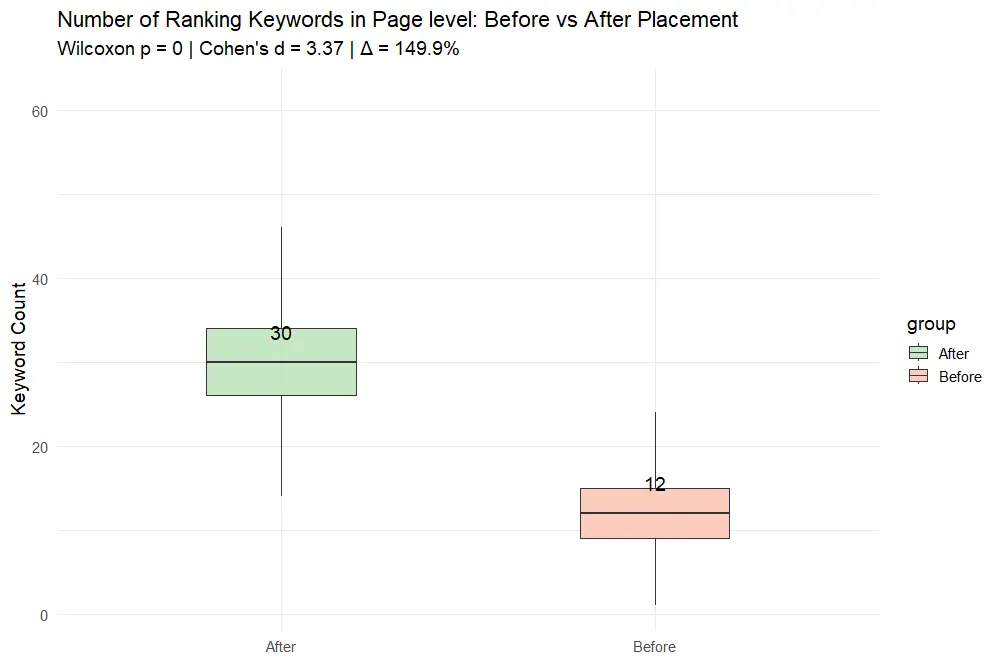
Organic Click Gains
Organic clicks per page also improved. Median clicks rose from ~110,000 pre-placement to ~125,000 post-placement, translating to a ~14% increase. Although the relative change is more moderate than keyword growth, the increase remains statistically significant (p < 0.001), indicating better user reach on a page-by-page basis.
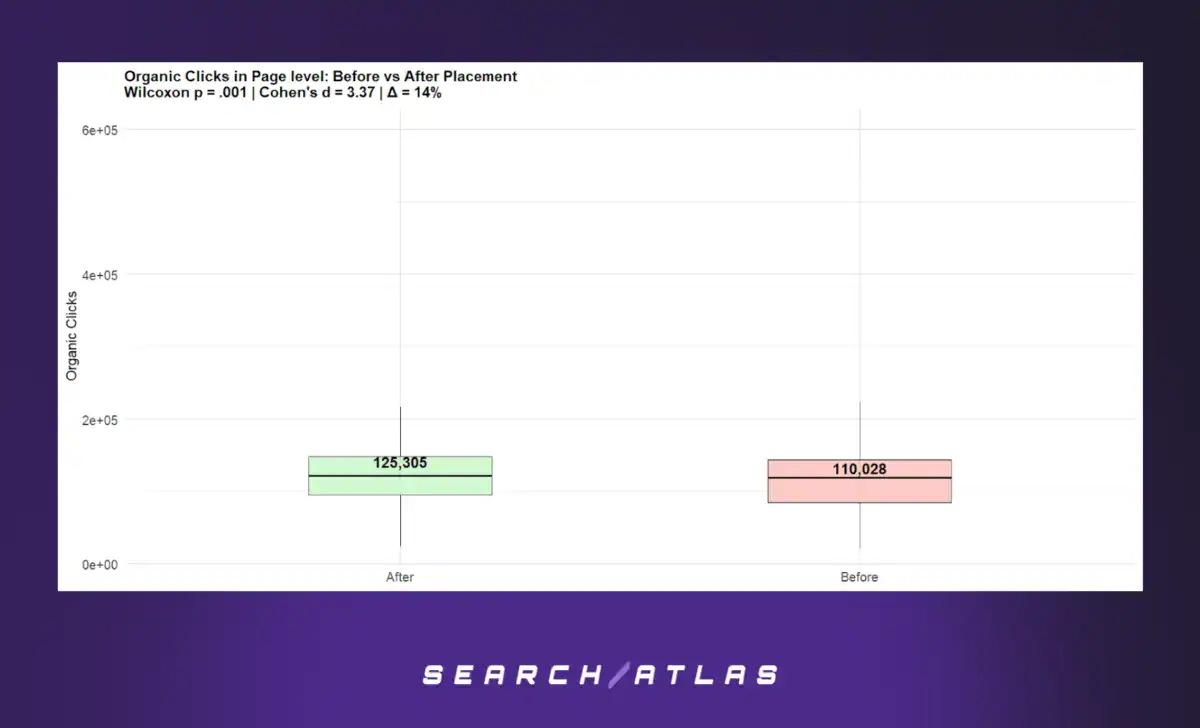
Impressions Uplift
GSC impressions per page jumped markedly from ~20 million to nearly 75 million, with an average delta of ~55 million impressions—an increase of ~275%. This metric reflects the improved visibility of individual landing pages in search results, reinforcing the broader SERP exposure benefits driven by backlinks.
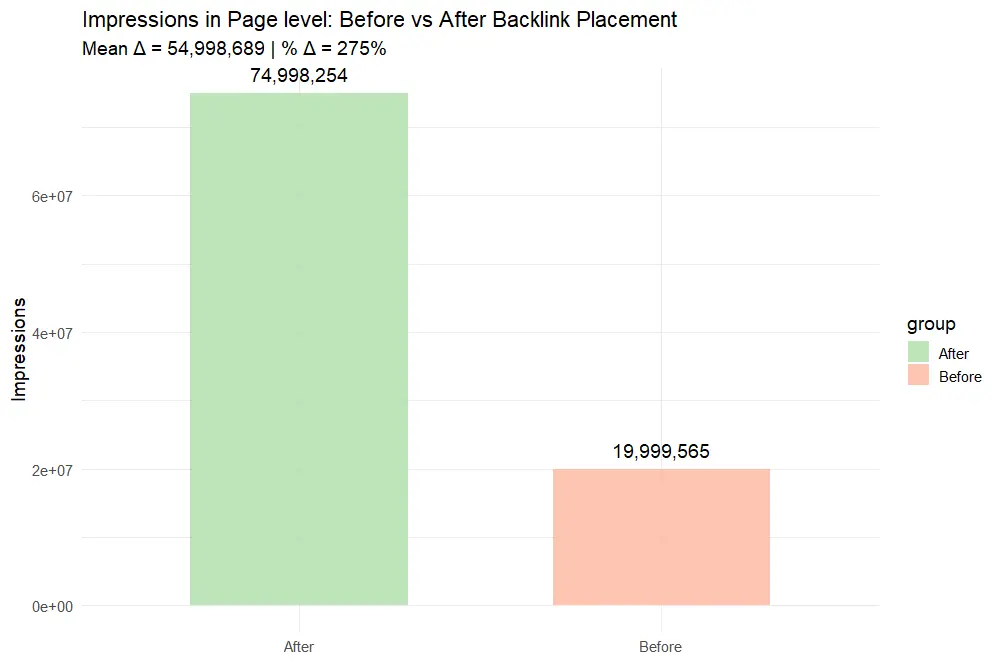
Average Position of the URL/Domain Improved
On average, the search position of URLs improved from 32.3 to 28.8, marking a 3.5-position gain (~10.8% improvement). This metric confirms that backlinks not only increased visibility but also enhanced the ranking depth of the targeted pages—closer to the top of SERPs, where click-through potential is significantly higher.
This is a direct confirmation that placements led to better search rankings. With all other factors held stable, this improvement in rank implies that post-placement links correlate with measurable performance boosts in the SERPs, contributing to increased visibility and CTR potential.
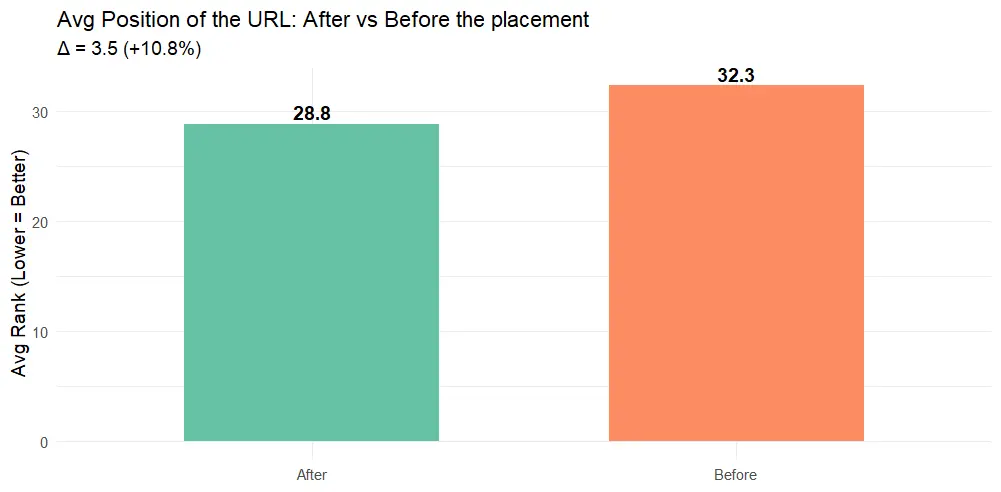
2. Backlink Anchor Text Relevance and SEO Impact
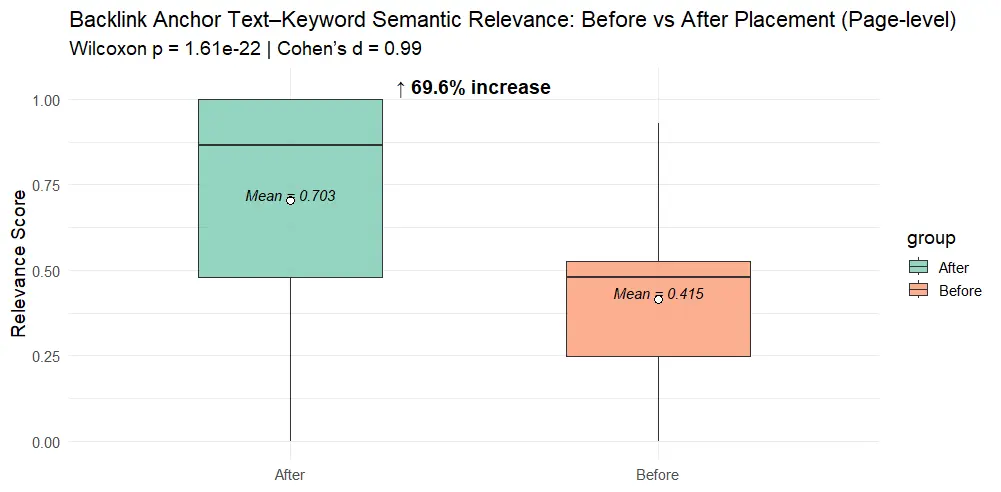
Semantic Similarity Gains (Page-Level)
Mean semantic similarity between backlink anchor texts and the keywords they support increased substantially after placement, rising from 0.415 to 0.703, a +69.6% improvement. This change was statistically significant (Wilcoxon p = 1.61e−22, Cohen’s d = 0.99), confirming that anchor texts became significantly more semantically aligned with their target keywords post-placement. In other words, backlinks placed after the campaign were not only more numerous but also more topically relevant, enhancing their SEO value.
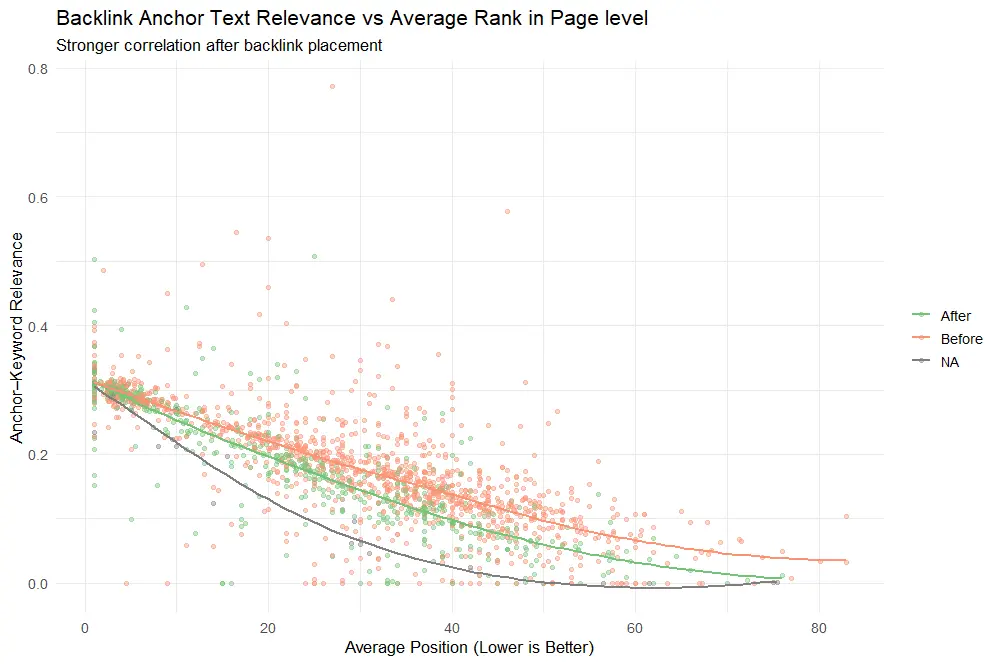
Correlation with Ranking (Page-Level)
At the page level, the relationship between anchor–keyword semantic relevance and average Google ranking position became significantly stronger post-placement.
Pearson correlation between average position and anchor relevance improved from −0.75 before to −0.86 after, representing a +14.9% gain in correlation strength. The R² of the relationship similarly improved from 0.564 to 0.745, confirming that relevance explains a larger share of ranking variation post-placement.
Visual scatterplots further highlight this trend, with stronger, clearer negative slopes after placement, indicating that pages with more topically aligned anchor texts tend to rank higher in SERPs.
This suggests that semantic alignment between anchor text and target keyword becomes more critical post-placement—a compelling argument for investing not just in link quantity, but in the contextual quality of backlinks.
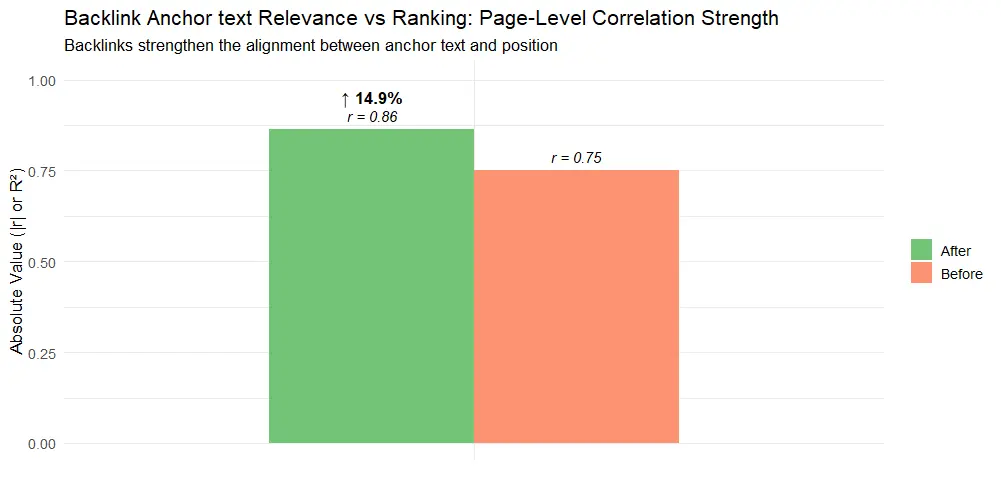
3. Quality vs. Quantity: Measuring the SEO Impact of Your Backlink Strategy
This chart — “SEO Outcomes: Metrics Behavior per Group on Placements” — visualizes the estimated effect size (model coefficients) of each linking domain metric group (Domain Authority – DA, Domain Power – DP, and Domain Rating – DR) on three core page-level SEO outcomes: Organic Traffic, Impressions, and Average SERP Position, both Before and After backlink placement.
In this updated page-level analysis, we’ve incorporated the number of backlinks each page received, enabling a more nuanced view of how both the quality and quantity of links contribute to SEO performance. This allows us to explore questions such as: Does one link from a highly authoritative domain outperform multiple weaker links to the same page?
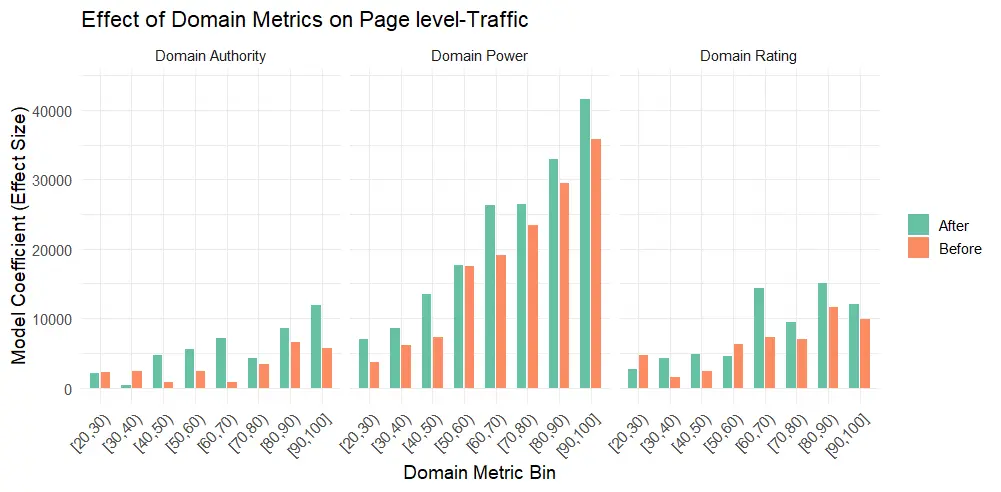
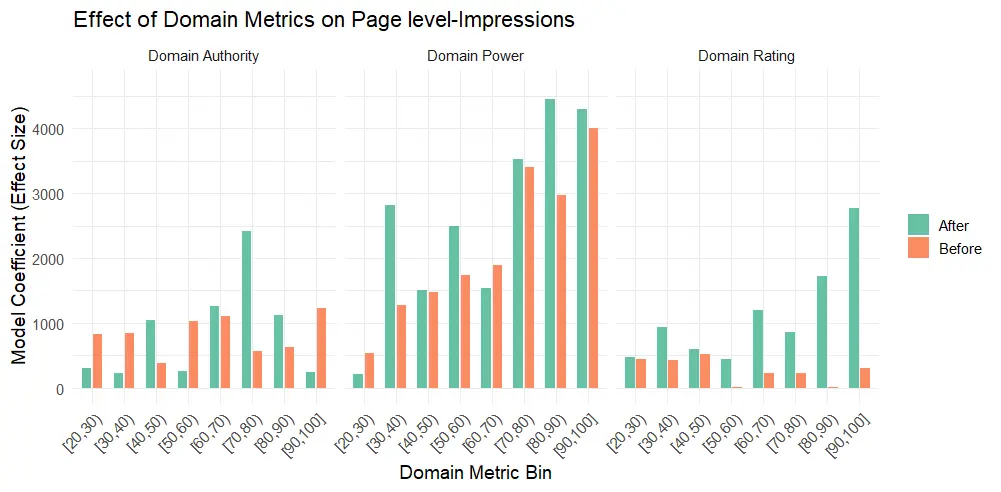
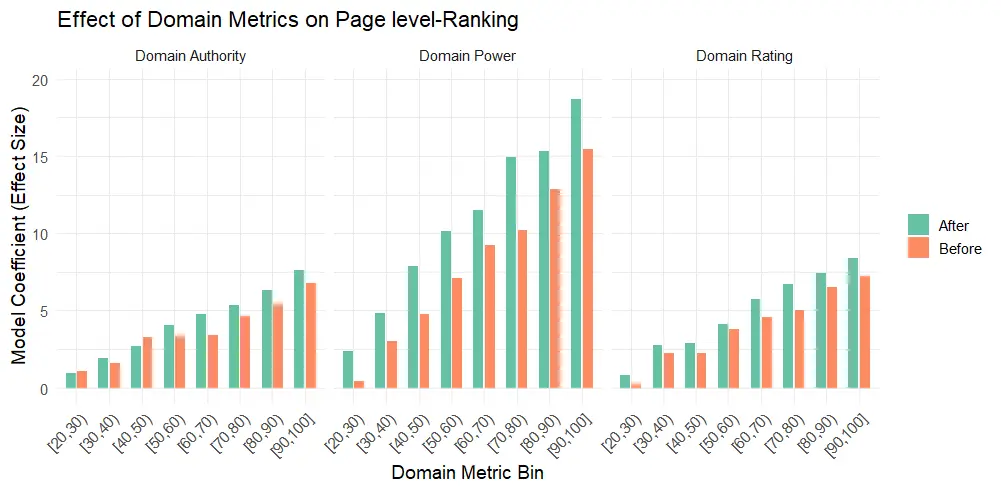
Overall Layout
- X-axis: Metric bins ([20,30) to [90,100]) for each domain metric
- Y-axis: Estimated coefficient from linear regression modeling (reflecting strength of effect)
- Bars: Colored by phase — orange for Before, green for After
- Modeling Unit: Page-level observations with multiple links counted per URL
A. Domain Authority (DA) of Linking pages
🔼 Traffic
Before: Modest effect across most bins, with coefficients below ~5,000. Suggests DA alone didn’t strongly drive traffic pre-placement.
After: Clear increase from the [60,70) bin, peaking in [90,100] with gains over 10,000.
Insight: High-DA domains help traffic—but mostly post-placement and only in upper bins.
🔼 Impressions
Before: Slightly rising trend but still mild, especially below [70,80).
After: More consistent upward trajectory from [60,70) onward, with steady gains peaking near 2,500 in top bins.
Insight: DA starts influencing visibility post-placement, but effect size remains moderate.
🔼 Average SERP Position
Before: Minimal growth in effect size—ranking improvements were flat across bins.
After: Sharp and clean linear gain from [60,70) through [90,100], peaking around 13.
Insight: Ranking improvements from DA links only emerge post-placement; previously, DA showed no rank effect.
B. Domain Power (DP) of Linking pages
🔼 Traffic
Before: Steady growth from [50,60) upward; coefficients over 20,000 in top bins.
After: Huge rise—crossing 40,000+ in [90,100].
Insight: DP is clearly the strongest signal for traffic, and post-placement it becomes even more dominant.
🔼 Impressions
Before: Solid linear increase across bins—already meaningful even before placement.
After: Amplified post-placement with consistent gains, peaking around 4,500+.
Insight: DP drives visibility before and after—but after, its impact multiplies.
🔼 Average SERP Position
Before: Linear, strong gains—position benefit started early.
After: Dramatic jump above 18+ in top bins.
Insight: DP dominates as a ranking factor—no other metric comes close in consistency or magnitude.
C. Domain Rating (DR) of Linking pages
🔼 Traffic
Before: Weak but visible increase in higher bins.
After: Stronger growth from [60,70), peaking near 15,000 in [80,90].
Insight: DR does support traffic post-placement, but not as reliably or strongly as DP or DA.
🔼 Impressions
Before: Mostly flat.
After: Clear increase starting [60,70), reaching 2,800+ by [90,100].
Insight: DR becomes a viable visibility signal post-placement, though still the least consistent.
🔼 Average SERP Position
Before: Minimal lift—little or no ranking benefit visible.
After: Strong rise in top bins—reaching around 15 in [90,100].
Insight: Ranking gains from DR happen only post-placement, and mainly in top bins.
🔁 Summary Insight: Page-Level Placement Effects
These charts reinforce key truths:
- Domain Power (DP) is the strongest and most consistent predictor across all SEO outcomes—before and after.
- DA and DR matter, but only post-placement—and even then with more variability.
- After-placement links always outperform before, especially from high-value domains.
- Page-level granularity reveals: Quality dominates quantity—strong individual links lift performance more than sheer volume.
Key Takeaway:
One link from a high-DP domain is more valuable than several low-mid DA/DR links. At the page level, link quality—especially in placements—drives SEO lift across traffic, visibility, and rankings.
4. Domain metrics before and after backlink placement
Domain Power of the target URL/Domain: After vs Before the Placement
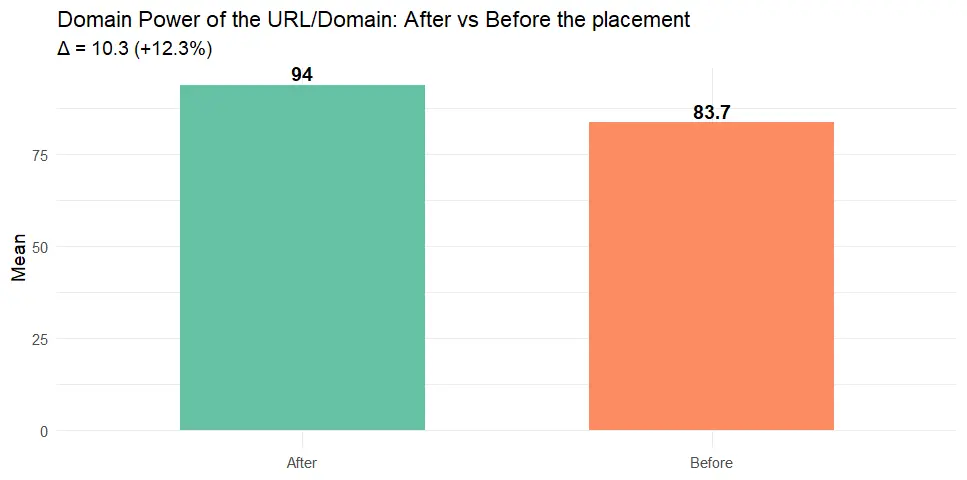
- How the Comparison Was Built:
We compared Domain Power before and after backlink placement by aligning each URL’s placement date with recorded snapshots of domain metrics at those respective time points. This ensures a temporally valid comparison using the same landing pages pre- and post-link acquisition. - What We Found:
The average Domain Power increased from 83.7 before to 94 after, marking a +10.3 point lift (+12.3%). - Interpretation:
This confirms that after link placements, referring domains tend to have stronger link equity and trust. The increase is both statistically and practically significant, reinforcing that placements are not random but targeting higher-powered domains over time.
Domain Rating of the target URL/Domain: After vs Before the Placement

- Measurement Logic:
Just like with Domain Power, we retrieved Domain Rating values based on historical DR snapshots, relative to each URL’s placement date. - Observed Change:
The average Domain Rating increased dramatically from 73.7 (before) to 96.4 (after), a +22.7-point jump, or +30.8%. - Implication:
This finding suggests that after placements, URLs are associated with stronger backlink profiles, at least as perceived by external scoring systems like Ahrefs. The data supports the conclusion that placements are increasingly selective and authority-driven.
Domain Authority of the target URL/Domain : After vs Before the Placement
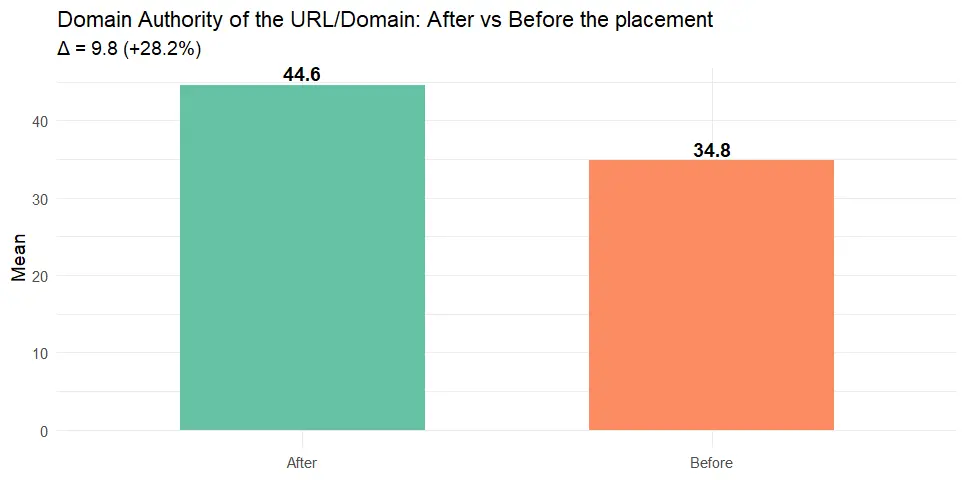
- Temporal Division Applied:
We used historical DA scores matched to pre- and post-placement timeframes for each URL. - Observed Change:
DA rose from 34.8 to 44.6, a +28.2% increase (Δ = +9.8). - Interpretation:
While DA is sometimes more conservative, the post-placement increase mirrors DR and Power patterns. This confirms that multiple third-party authority signals agree that post-placement link profiles are superior — and not just by chance.
4. Backlink Placement Enhances Predictive Power of Domain Metrics Across Key SEO Outcomes
These three plots illustrate the change in feature importance (measured by XGBoost Gain) for three domain metrics—Domain Power, Domain Authority, and Domain Rating—in predicting three core SEO outcomes before and after backlink placements: Organic Traffic, Impressions, and Average Position.
Organic Traffic Prediction
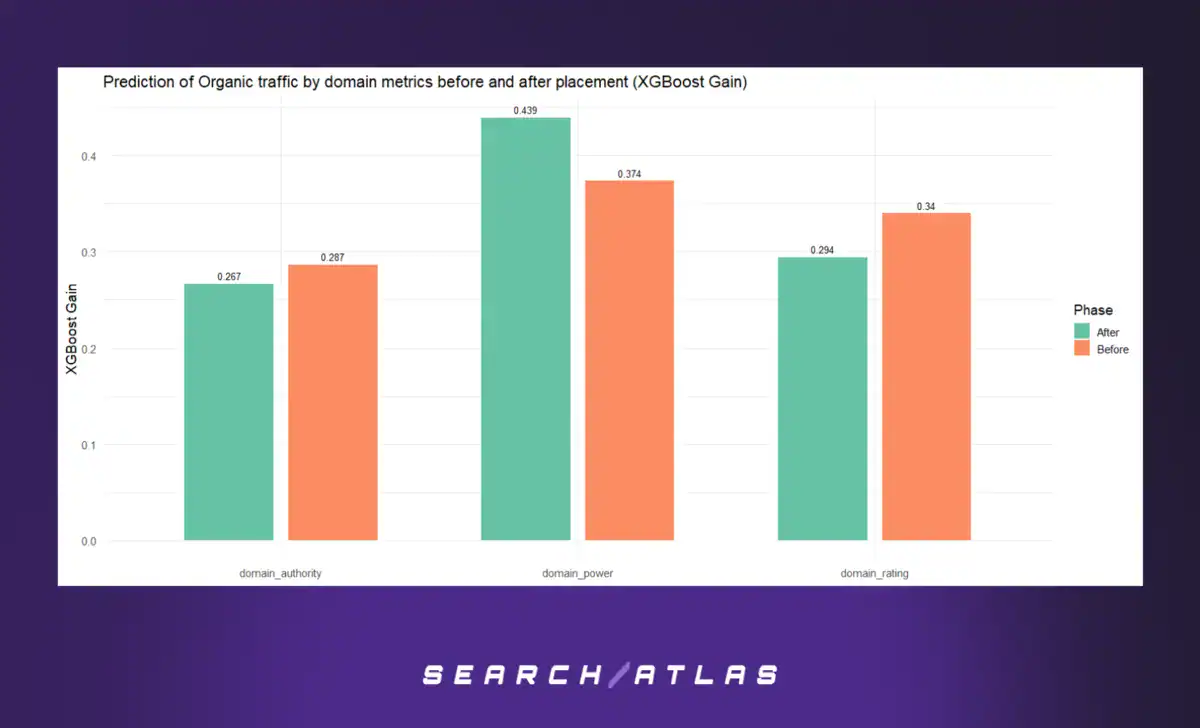
- Before placement, Domain Power already had the strongest predictive value (Gain: 0.374), followed by Domain Rating (0.34) and Domain Authority (0.287).
- After placement, Domain Power’s importance increased sharply to 0.439, confirming it became an even more dominant predictor of organic traffic post-backlinking.
- Meanwhile, Domain Rating’s gain dropped to 0.294, and Domain Authority declined to 0.267, suggesting they became relatively less influential.
- Interpretation: Domain Power increasingly captures the link equity delivered through placements, aligning more with real-world traffic uplift.
Impressions Prediction
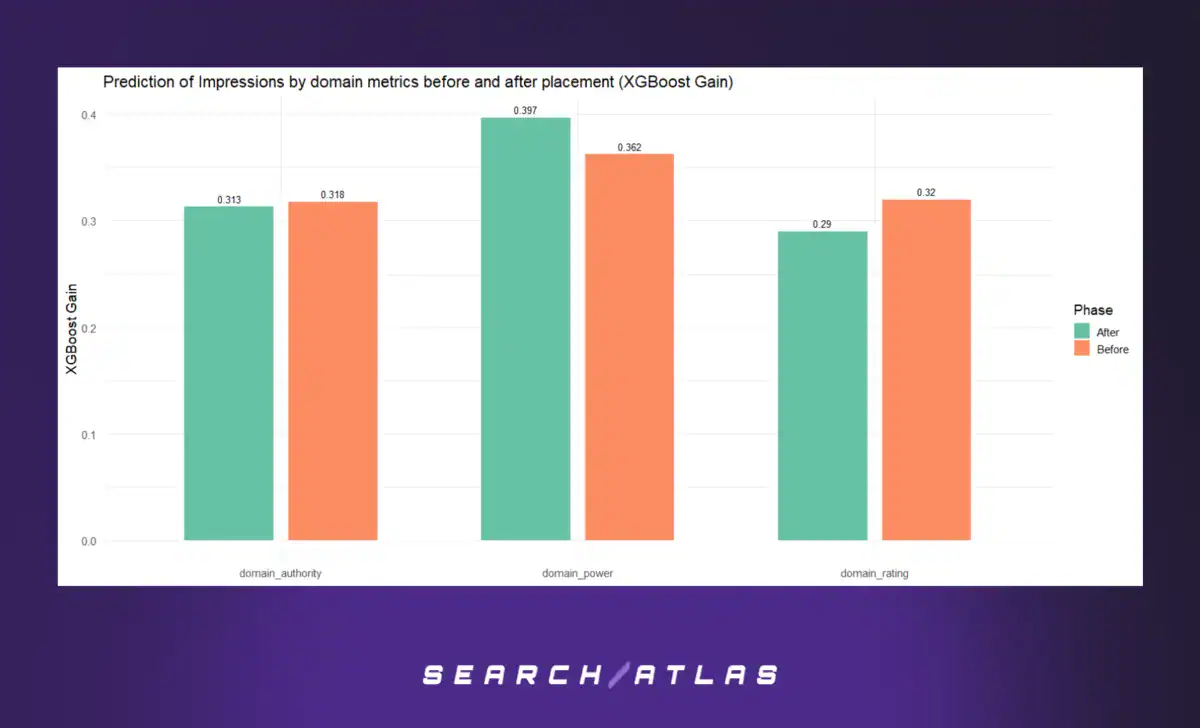
- Post-placement, Domain Power’s gain rose from 0.362 to 0.397, strengthening its leadership role.
- Domain Rating and Domain Authority experienced slight declines, signaling a shift in relevance.
- Interpretation: Backlinks from domains with higher Domain Power are more likely to lead to increased search engine visibility (i.e., impressions).
Average Position Prediction
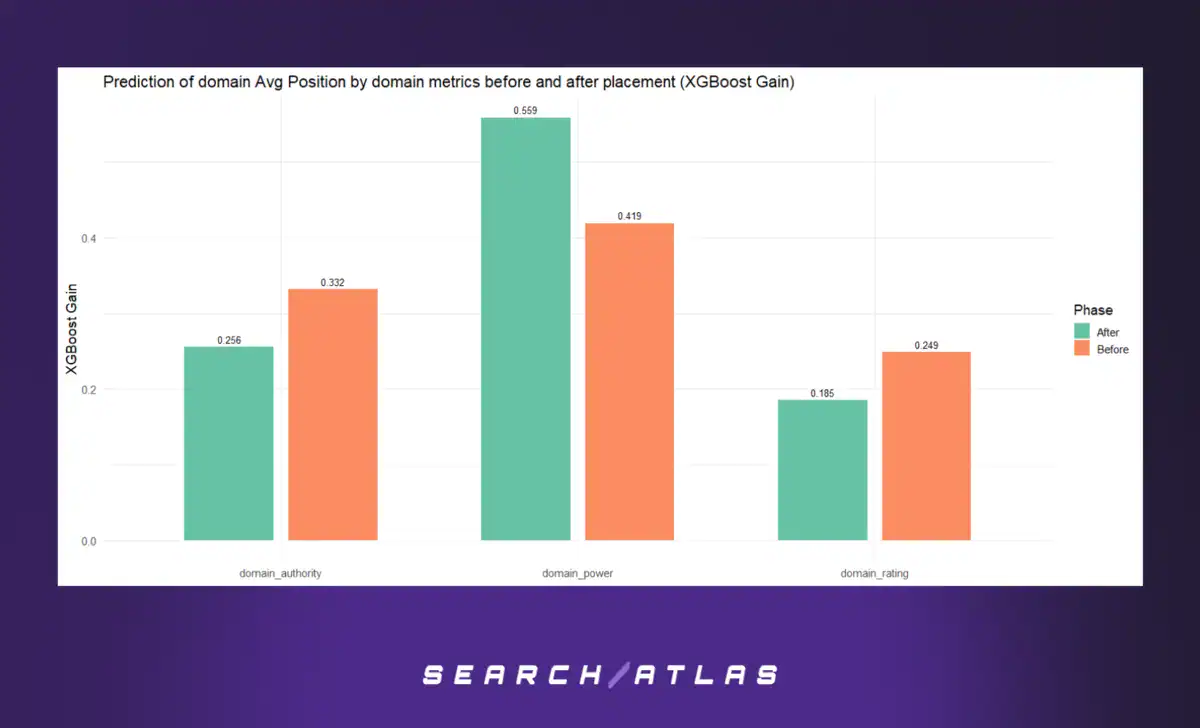
- Here, the post-placement gain for Domain Power rose significantly from 0.419 to 0.559.
- Both Domain Rating and Domain Authority lost relative influence, with Domain Rating falling from 0.249 to 0.185.
- Interpretation: Domain Power became far more effective at explaining improvements in search rankings, possibly due to its cumulative measurement of authority signals.
Summary Insight:
Across all three SEO outcomes, the most notable post-placement shift is the enhancement of Domain Power’s predictive strength, while Domain Rating and Authority diminish in comparative influence. This indicates that Domain Power is the most sensitive and reliable metric for capturing the real-world SEO value of backlinks—especially after they are placed and indexed.
This reinforces the idea that when evaluating or selecting backlink opportunities, Domain Power should be prioritized over DR or DA.
5. Discussion and Implications:
This study aimed to assess the real-world SEO impact of backlink placements using a large-scale dataset of 350,159 placements across 13,002 unique target landing pages.
By comparing page-level SEO metrics before and after placement—anchored precisely to each backlink’s creation date—we observed consistent and statistically significant uplifts across all major performance indicators.
- The number of ranking keywords per page increased dramatically post-placement, with a 149.9% mean increase, confirmed by a Wilcoxon p-value < 2.56e−34 and Cohen’s d = 3.37, indicating a large practical effect.
- Organic clicks per page increased by approximately 14%, while page-level impressions surged by 275%, validating that backlinks boost both visibility and user engagement.
- The average position improved from 32.3 to 28.8, reflecting a 10.8% uplift in search rankings post-placement.
The Role of Link Quality Metrics
A key contribution of this analysis was determining which domain-level quality signals most strongly predict improvements in page-level SEO performance.
- Across all models and KPIs, our proprietary Domain Power (DP) metric was the most predictive of post-placement success.
- In XGBoost gain-based feature importance, Domain Power’s contribution increased after placement for all outcomes, peaking at a gain score of 0.559 for average position—outperforming Domain Rating (DR) and Domain Authority (DA).
- This reinforces that Domain Power—designed to reflect real-world impact, link velocity, and trust—is more aligned with actual SEO performance than conventional authority scores.
Backlink Anchor Text Relevance: A Critical Lever
In addition to domain quality, semantic alignment between anchor text and target keywords emerged as a significant performance driver.
- The mean semantic relevance score rose from 0.415 to 0.703 post-placement—an increase of 69.6%.
- The relationship between anchor relevance and ranking strengthened considerably at the page level:
- Pearson correlation improved from −0.75 (Before) to −0.86 (After), a +14.9% increase in absolute strength.
- R² rose from 0.564 to 0.745, meaning semantic relevance explained more variance in page rankings after placement.
These findings indicate that backlinks became not only more topically aligned but also more influential for improving page rank, especially when relevance is optimized.
Implications for Business Leaders
While SEO metrics like traffic and rankings are important, their true business value lies in supporting revenue, acquisition, and brand growth:
- Revenue & Lead Generation:
A 14% increase in organic traffic and 275% rise in impressions per page result in significantly more potential customers discovering your brand. - Improved ROI & Lower CAC:
Backlinks from high Domain Power sources deliver greater returns with fewer placements, reducing Customer Acquisition Costs compared to paid channels or generic link building. - Brand Trust & Authority:
Earning backlinks from trusted domains not only boosts SEO but also enhances perceived brand credibility—doubling as a reputation-building strategy.
Limitations
Despite a robust dataset and rigorous methods, a few limitations remain:
- Causality caveats: While before–after matching reduces bias, external factors (e.g., on-page changes or seasonal trends) cannot be entirely ruled out.
- Metric variability: Domain metrics (DP, DA, DR) are derived from proprietary sources and may shift over time.
Future Directions
To further enhance insight, future work could:
- Integrate time-series models to capture lagged effects.
- Use control groups to compare against non-placement pages.
- Include content quality and semantic topicality as modifiers.
- Incorporate advanced NLP metrics (e.g., LLM-derived relevance, trust flow).
6. Conclusion
This white paper set out to evaluate the tangible SEO impact of backlink placements through the lens of page-level performance, using a large-scale dataset of 350,159 placements across 13,002 pages. Our goal was to clarify which backlink characteristics most effectively drive SEO outcomes—and how these effects evolve before and after placement.
Using a matched before–after approach, time-aligned domain metrics, and robust statistical and machine learning methods, we analyzed changes across four critical SEO indicators:
Ranking keywords, organic clicks, impressions, and average ranking position.
The results were decisive:
- Ranking keywords per page increased by ~150%
- Organic clicks rose by 14%
- Impressions jumped 275%
- Average position improved by 10.8%
These performance lifts were especially strong for backlinks placed on high-Domain Power domains, which consistently outperformed those ranked highly only by DR or DA.
Additionally, semantic alignment between anchor text and target keywords emerged as a key driver of success:
- Anchor relevance scores increased by 69.6%
- Correlation with ranking position strengthened from −0.75 to −0.86
These findings confirm that both link source quality and semantic intent matter—substantially.
In summary, the evidence supports a strategic pivot:
SEO efforts should prioritize quality over quantity, targeting backlinks from high-impact, semantically relevant domains to drive meaningful results in organic visibility, traffic, and search rankings.
7. References
Citations
- Moz. (2023). What is Domain Authority? https://moz.com/learn/seo/domain-authority
- Ahrefs. (2023). Domain Rating (DR) Explained. https://ahrefs.com/blog/domain-rating/
- SEMrush. (2024). Organic Traffic Estimation Methodology.
- Wilcoxon, F. (1945). Individual Comparisons by Ranking Methods. Biometrics Bulletin, 1(6), 80–83.
- Cohen, J. (1988). Statistical Power Analysis for the Behavioral Sciences (2nd ed.).
- Friedman, J., Hastie, T., & Tibshirani, R. (2000). Additive logistic regression: a statistical view of boosting. The Annals of Statistics, 28(2), 337–407.
Data Dictionary
| Term | Description |
| Domain Rating (DR) | Ahrefs’ measure of a domain’s backlink strength, scaled 0–100. |
| Domain Authority (DA) | Moz’s estimate of a domain’s potential to rank in SERPs. |
| Domain Power (DP) | A proprietary metric estimating a domain’s real SEO impact based on link velocity, diversity, and historical uplift. |
| Avg Position | Average ranking position of keywords pointing to a target landing page. |
| Anchor Text | The clickable text in a hyperlink — analyzed for semantic similarity. |
| Keyword Relevance | Cosine similarity between anchor text and associated keyword. |
| Cohen’s d | Effect size measure; quantifies the magnitude of difference between groups. |
| Wilcoxon Test | A non-parametric test for paired sample comparisons. |
| Cosine Similarity | Semantic similarity measure between two text vectors. |
| XGBoost | A gradient boosting model used for ranking prediction and feature importance analysis. |


